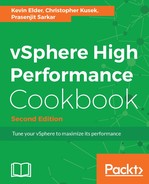High availability is an important feature of any mission-critical system, and VCSA is no exception. Since your VCSA system manages your entire virtualized environment, it needs to be able to recover from hardware and software failures. When using VCSA in vSphere 6.5, you can configure vCenter Server High Availability (VCHA). If VCSA fails, VCHA is designed to carry out the failover and be back up and running in less than 5 minutes. VCHA is only available with VCSA and is not available for vCenter running in Windows.
VCHA consists of an active and passive VCSA and a witness. The active VCSA does synchronous vPostgres DB replication and file replication to the passive VCSA. There is also a floating management IP address that is tied to the active VCSA. If the active VCSA goes offline, the passive VCSA and the witness will create a quorum, take over the floating IP address, and become the active VCSA. If the offline VCSA comes back online, it becomes the passive VCSA and begins syncing with the active VCSA.
Implementing VCHA requires a few extra components. First, you must have a VCHA network for your two VCSA nodes and the witness to communicate. This network does not require 10 Gbps speed, but latency should be 10 ms or less. You must also have three additional IPs allocated: one for each VCSA and one for the witness. These IPs need to be on a different subnet than the floating management IP of the active VCSA. In addition, your VCSA should be at least a small configuration with 4 vCPUs and 16 GB of RAM.
There are two ways to deploy VCHA: basic and advanced. Basic deployment is automated via a wizard, and advanced is a manual process. We will configure VCHA using the basic option.
